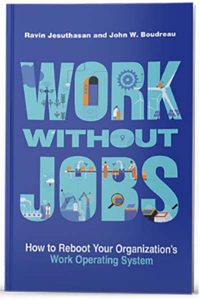The Future Of Work: Work Without Jobs With Ravin Jesuthasan
What does the future of work look like? How do we integrate technology and human job skills to create a successful work operating process? Today’s guest has the answers you need. Ravin Jesuthasan is a recognized global thought leader, futurist, and author of the future of work, automation, and human capital. In this episode, he shares helpful insights for businesses industries over. With key concepts from his book Work Without Jobs: How to Reboot Your Organization’s Work Operating System, Ravin enlightens on helpful strategies that facilitate optimal outcomes for your business. He dives into topics such as the democratization of work, digitalization, deconstruction, and the benefits of an internal workplace marketplace. There’s a lot of valuable insight on today’s episode that you won’t want to miss. Tune in to learn about concepts that could help you advance in this quickly changing work market.
—
The Future Of Work: Work Without Jobs With Ravin Jesuthasan
This is the place where we engage, energize and elevate your employees and your company. We’re so happy that you’ve joined us on many different types of media platforms. I am joined by my many esteemed colleagues here. I’m a People Strategist. I’ve worked in human resources and talent management strategy for many years, and I’ve had the wonderful opportunity of starting up and operating my own businesses with my own employees.
I’ve had the joy of utilizing many of these techniques. I want to mention there are a few other people here that are not joining us, Howard, Jules, and Sumit. I also want to introduce Sam Reeve. He’s a Rewards Strategist. This guy knows his stuff around compensation and total rewards strategy. It’s a pleasure. Thank you, Sam, for all the time you’ve been sponsoring this wonderful show. Wendy Graham is going to be joining us.
It’s a pleasure to be here.
I can’t even give the full resume that you have got everything, the learning and development, leadership development. Also, helping us with OD type of support and have a great perspective as well and championing this show over time.
—
In this episode, our special guest speaker is Ravin Jesuthasan. Ravin is a global thought leader, a futurist, and a Wall Street Journal bestseller. He’s led numerous research projects for the World Economic Forum, including shaping the future, the implications of digital media for society, and HR 4.0. He’s also been named one of the top 25 most influential consultants by Consulting Magazine. We’re very grateful that he’s here with us. Please help me give a warm welcome to Ravin.
Thank you. It’s great to be here with you.
I tried to spit out the mouthful of your amazing qualifications. Could you go through your background and what you’re all about? What do you offer employers, leaders, and employees?
My background is a little different. As I write about organizations needing to perpetually keep reinventing themselves, my journey has been one of perpetual reinvention. I’m a retreaded finance guy. I was a strategy consultant. I’ve been a consultant for many years. I’ve never had a real job, but I’ve had the privilege of continuously experimenting and practicing in many different areas.
I mentioned I was a strategy consultant. I’m a chartered financial analyst. I was an exact comp consultant. I ran the rewards business, one of the largest global rewards businesses, for several with my previous employer. I ran their talent management business. I’ve been consulting about the future of work since 2007. I don’t think we were calling it the future of work back in 2007, but it was around how work was transforming and fundamentally changing.
I had the privilege of a lifetime to collaborate with my good friend, John Boudreau, in writing our full books together. I have also been blessed enough to work for the World Economic Forum for a few years on their steering committee on work and employment. I participated in probably about ten different research studies with them on the future of work. My colleagues and my clients give me the opportunity to keep pushing the envelope. It’s great to be here with you all.
At the end of our discussion, can you be sure to talk about your books and how people can find those? That would be very interesting because you have so much different information. I want to say that Sam Reeve has been doing his homework. He was sharing with us all his different questions. Sam, do you have some questions?
Ravin, I’ve been diving into your book Work Without Jobs. I know this is a huge topic now, especially with a lot of my clients wondering more about how to create more opportunities for their people and have more satisfaction around work-life in general. Can you tell us a little bit more about what is the future look like when we’re talking about Work Without Jobs? Can you dive into that a little bit more for our readers?
I’m happy to, Sam. By way of context, John and I started writing Work Without Jobs in March 2020. I could not have picked a better/more challenging time to start writing a book about the future of work because what we subsequently saw over the course of the few years was a transformation unlike any other. In June of 2020, Satya Nadella, the CEO of Microsoft, said that we’ve seen a two-year trend in digitalization get realized in the last few months of the pandemic.
When we look back on this pandemic, the impact on the future of work has been far more profound. It’s not digitalization that has accelerated the future of work, but it’s that other arguably more powerful, maybe more insidious force called the democratization of work. It’s our growing ability to increasingly decouple work from its traditional confines of space, time, and structure. When you overlay those two forces against each other and look at how they’ve played out over the last few years, we’ve seen something more like a twenty-year trend in the future of work get pulled forward in the last few years.
We've seen something more like a 20 year trend in the future of work get pulled forward in the last two years. Share on XJohn and I were blessed enough to be able to sit on this. Not just sit on the sidelines but roll our sleeves up with a number of organizations as they were transforming through this pandemic. We’re given the opportunity of turning those experiences and experiments into ideas and what manifests itself in this book in what we’re calling a new work operating system, one that is underpinned by work, tasks, skills, and capabilities as the currency for work instead of the job.
Here’s a little bit of context, Sam, as to the context within which we wrote the book and why we think we’re seeing a transformation unlike any other. Hopefully, this book is helpful to the many business leaders who’ve been kind enough to buy it to help them navigate. Not where we are now but what’s to come over the course of the next couple of years.
I’m so glad you’re diving into the topic because I’ve been looking for information here for quite some time on how to operationalize and think about the job deconstruction process. If we look out throughout history and how we go about doing work and labor, it’s a set or a series of tasks we need to complete.
It’s a natural understanding that a traditional job is made up of a series of tasks and so forth. What’s driving this change more now? I know there are things that you talk about in your book, such as the impact of automation and the way that people are thinking about work. Can we dive into that a bit? What is driving this need for job deconstruction?
As I said to him, it’s those two forces. It’s digitalization, the number of work options we now have, whether AI, robotic process automation, gig talent, internal talent marketplaces, onshoring or offshoring. We have a plethora of different options for getting work done. Those options don’t often become visible until we move beyond the job to the elemental tasks that make up the job. It’s those two forces, the democratization of work and digitalization, that require us to think of different ways of getting work done.
From an external context perspective, the quantum and pace of change have probably never been greater. We talk about these Black Swan events like the pandemic as being this various peace we might experience once every generation. If you think about it, Sam, we’ve had full Black Swan events in many years. We’ve had 9/11, the financial crisis, the pandemic, and now we have the war on Ukraine.
Four major events have disrupted work and global economies, unlike anything we’ve ever seen going back over a pretty long period of time. The need for business models to be much more agile, resilient, and flexible is at the heart of why John and I wrote this book, a work operating system that enables both the enterprise and the talent to be able to stay relevant for a rapidly and dramatically changing world.
Let’s talk a little bit more about the work operating system. Can you break that down, describe what that means, and the pieces that are a part of that?
With this new work operating system that is characterized by tasks, skills, and capabilities versus that fundamental construct of the job, the first is starting with the current and future work of the organization. Not how we organize the work into jobs, job families and jobs into job families, job families into functions, organizations, etc. It’s transcending that legacy of jobs.
Once you figure out the work that is there and that’s to come, what are the optimal combinations of talent and technology? This is something that John and I have done a lot of work on. We talk about it in chapter two of the book. Our book, Reinventing Jobs, which was published by the Harvard Business Review in 2018, laid out a roadmap for business leaders on how to get to that optimal combination. What we’ve seen consistently, and we illustrated this with about 130 case studies, is companies that lead with the technology often end up with suboptimal outcomes.
The companies who lead with the work see the nuances in terms of the relationship between talent and automation. They see which highly repetitive rule-based work might be substituted, where human ingenuity, creativity, empathy, caring, and concern can be augmented by technology, making that person almost super productive. They also see where the presence of automation either creates the space for new human work or demands new human skills. That’s the second principle.
Once you have figured out the right combination of talent and technology, humans and automation, the third principle is about considering the full array of ways in which talent can engage with work. Should it be a job? Should it be an internal talent marketplace, which, as you folks know, is one of the hottest topics in HR and organizations now? Should it be a gig worker? Should it be a freelancer or an alliance partner? What’s the optimal, most sustainable way for talent to engage with the work? Lastly, how do we ensure that we’re consistently taking the frictional cost of work out, enabling talent to flow to work increasingly, enabling talent to keep connecting with work through ever more seamless means versus being bound up in that legacy construct of a job?
That’s so important. A lot of our readers are probably thinking, “This is something that’s huge. It’s revolutionary.” It’s something that a lot of people out there know that this is a way to remove that friction from organizations to create a sense of happiness and opportunity and so forth. The thing is, where does one begin? Now, what you were talking about is technology, and HR leaders out there are saying, “Yes, but my human capital system is built around jobs, the traditional model of bringing people in and transferring through the talent management model. How do I start with this change? What do we do?”
Let me respond in two ways in terms of where you might want to get started. What we talk about in the book is identifying some of the tipping points. Often the tipping points in organizations are the ones you would typically think of, Sam. We can’t find enough talent. I’m sure you’ve never heard that one before. If we can’t find enough talent, instead of looking for that perfect candidate, how might we deconstruct the jobs, redistribute some of the activities to different roles, and then create a specific body of work that allows more people into the game and bend the demand curve of work?
One of the examples we had in the book was work that Greg Taylor and his team at Providence Health have done, which is outstanding work. At the height of the pandemic, nurses were stressed out and had demands placed on them, unlike any other time. What they did was to help nurses float to the top of their licenses by reinventing and redesigning the jobs of nurses.
Looking at where automation could take on tasks, slower down in the priority list where other talents could take on some of the work so that nurses were well preserved for the things that have the most value, the things that they came into the profession. We are redesigning work to address the issues and challenges with the supply of talent. That’s often one area.
The democratization of work and digitalization are requiring us to think of different ways of getting work done. Share on XThe second is if you’ve got new technology coming into the organization. Your business leaders have made a decision to go implement a new set of automation in your warehouses or new types of robotic process automation for your contact centers, etc. Work with them to identify, “What does this mean for the work that’s being done now and work that might be done?” We illustrate this in the book. The running case study we have is of a very large global retailer that implemented new technology and found that their costs went up instead of going down.
What they hadn’t anticipated was that the presence of that automation was going to demand some very different skills. At the same time, because the existing talent was spending time triaging around that machine, they couldn’t move them on to other activities that they needed them full. New technologies are often a good trigger point for starting to pilot an experiment.
The third is if you’ve got a bottleneck in a process. It could be an HR process. It could be an operational process. How might we deconstruct the different activities and find ways of redeploying them elsewhere so that we get to an outcome that looks more fundamentally different? Those are three trigger points in terms of how you might get started. I want to step back from your point about HRIS because I also want to give the readers three ways of thinking about how you can connect talent to work. I often get accused of, “Is the title of the book clickbait to get people to buy the book?” It’s so provocative.
We’re not saying the jobs are going to go away completely. Far from it. What we’re trying to illustrate is that the title points to the growing inability of this current work operating system based on jobs to keep up with the threats that I talked about, like pandemics, wars, etc., to keep up with the proliferation of digitalization, and to keep up with the change that’s required in terms of changing nature of globalization. It’s only when we move beyond that one-to-one relationship between a degree, a job, and a job holder to the many-to-many between skills and work that we start to create the conditions for the resilience and agility required.
We expect jobs to still be here but as you think about the future of work, think of three different ways of connecting talent to work. One is, where does the job still make sense? It’s because you’ve got compliance or control reasons. You’ve got plain basic economics. The volume of work necessitates a person in a job doing that work. The infrastructure for that, Sam, as you’ve alluded to our job architectures and ERP systems, is based on the notion of a person in a position.
The second model is where you might have someone in a job, but they have the flexibility to express their skills in other parts of the organization where they’re needed or acquire new skills. This is where you start to see this hybrid condition of both the job and the skills being the currency of work. It’s why we see many companies introducing internal talent marketplaces like Gloat and Eightfold and many others out there as a way of driving that mobility and enabling the transition to skills as the currency of work.
The third model that I think of is flow to work. It’s the three models of fixed, flex, and flow. Not to be too cute about it. The third model on the flow model is what I think of as being agile on steroids. How do we create a completely skills-based architecture? All of the talents might be our employees. They might be gig workers, but they’re connecting to work through these marketplaces that are matching their skills and capabilities to projects, assignments, and gigs continuously as opposed to being connected to work through that thing called a job. Those are three models that I hope are helpful and help in crystallizing how we see work evolving.
That’s very helpful. Thank you. Employers are out there saying, “It takes me 3 to 6 months to hire a person.” We’re now talking about breaking this job down into a multitude of tasks and going out to the marketplace, whether internal or external and finding people on the go. How can we do this faster? Is it a faster model? Tell me a little bit about that.

The Future of Work: It’s not just digitalization that has accelerated the future of work, but it’s that other arguably more powerful, maybe more insidious force called the democratization of work.
What this does is it enables you to source talent quickly. Now, our solution to resourcing the organization is to keep bending the supply curve. We pay people more. We offer them different benefits, etc., because we have all of these things bundled into a thing called a job. We have to find the perfect candidate for that particular job versus if you could deconstruct the job and redeploying the activity. Some of them might go into automation. Some of them might go to existing talent.
You can create a body of work that is much more accessible to many more people and get more people in the game. Shameless plug for what my colleagues at Mercer are doing, but we’ve also developed a software tool that enables companies to do this in seconds. It’s essential because it allows you to create not more access to work, but it lets you significantly reduce the time to fail. It lets you improve the productivity of the talent. Also, most importantly, it reduces the cost of work, which is going to be something that is continuously asked for as we look to improve the productivity of the workforce.
I have a question here, and I love the organizational and talent management strategies that you’re speaking of with three different models. As a more traditional HR person in the past, as well as my own company, here’s one of the biggest challenges when we talk about automation, technology, and moving into that aspect. Also, you’ve talked about nurses that we’re going to take away some tasks to make it easier for you.
One of the biggest challenges is the mindset and the psychological aspect of telling an employee, “We are going to bring in technology. We’re going to bring in different models in order to make your job easier.” I’ve even seen this with physicians with TeleMed, etc. How do we go through the change management cycle and process of helping people know it’s not about taking away their jobs?
“This change management process is not about taking away from what you currently do every day. It’s only going to enhance your role and make you more effective and better at the skill set and what you came into this industry for.” How do you deal with the change management side of the psychological aspects of helping an employee through this process?
I always tell our clients, “You have to do three things.” You have to have the people who are doing the work and be the ones at the table and helping with the reinvention. It’s involvement as opposed to some transformation team elsewhere, issuing a decree that this is our work is going to be done. It’s by getting them actively involved, getting them to see how this new automation could potentially help free them up for other bodies of work, etc.
They have to have an incentive to want to participate. That could be financial incentives if they could be other incentives. They also have to have the safety and the space to ensure that as they contribute, they’re not designing themselves out of a job. Whether it’s the promise of, “Whatever happens, we’re not going to lay you off. We’ll find a way to transition you to another role,” I’ve seen that with a number of our clients.
You need those three things. You need the voice of the talent and their involvement. They need to have an incentive to participate. They need to have safety in the space to know that they will continue to be relevant. That could be up-skilling or re-skilling for adjacent or reinvented roles as automation comes in and as new work gets added.
Companies that lead with the technology often end up with suboptimal outcomes and the companies who lead with the work actually see the nuances in terms of the relationship between the talent and the automation. Share on XThere are two pieces here that have to happen, like dating. We have employees or the workforce, and then we have the traditional job, the tasks, the projects that need to be done. In the process of bringing these two together, first, we have to understand the talent pool. What skillsets do they have? We’ve been thinking about this from a traditional job perspective, or if you’re an accountant, you must know this body of knowledge. We have to break down talent a little bit more. We had to understand their different skillsets, talents, drives, and passions. How are companies going about discovering more about their talent pool?
This is one of the reasons why we’ve seen such interest and an uptick in demand for talent marketplaces, talent insight platforms, etc. I’ve heard this, and I’m sure you guys have heard the same thing from your clients for decades. It’s much easier for our people to find opportunities outside the company than within the company.
Outside the company, you’ve got LinkedIn, which has all of this great data about all of us because we’re much happier putting stuff on about ourselves on LinkedIn than we are telling the HRIS system about the skills we have, etc. The availability of information externally is much greater. Organizations, from a talent acquisition perspective, often have a leg up on the internal, but this is where companies are starting to use these insight platforms to start to infer skills and aggregate and create a much better picture of the talent they have so that they can be deployed either to jobs, assignments, projects, etc., within the organization.
To give you a sense of the power of these platforms, in 2021, the World Economic Forum ran a test for one of its industry groups. The idea was to use one of these platforms to enable the mobility of talent across the industry, from suppliers to retailers, etc., as an example. One of the things they did was have employees in these companies tell them about the skills they had, and at the same time, ran a pilot where the algorithm was inferring skills based on people’s work history, the projects they were on, their education, previous employers, etc.
The average employee list was about 70. When the algorithm inferred the skills, the average list was about 24, more than 3X the number of skills inferred. The algorithm is imperfect, but it’s giving you a much better enriching starting point for understanding the skills of the workforce so that you can connect those skills to the requirements of different tasks and activities in the organization.
Skills are one part of the equation but understanding how competent a person is at a skill or how well-developed that is. What are companies doing to understand the competence equation there?
You’re right. There is a skill, then there’s capability. I am capable of expressing the skill, and I’ve got a demonstrated track record in doing that. That’s something that many organizations in desire for the shorthand of one thing that captures this pivot from jobs to the new world of work. Many focus on skills in terms of the potential to do something.
I think equally to your point, having the capacity or the demonstrated track record of having done it is an equally important consideration. With the algorithms, you’re able to infer whether that capacity or that capability has been demonstrated by looking at different projects the person might have taken on, different jobs they might have had, and different initiatives they might have participated in. It also is a good supplement to the more traditional approach of testing and validation.

The Future of Work: We have a plethora of different options for getting work done, and those options don’t often become visible until we move beyond the fundamental tasks that make up the job.
I imagine the companies you’ve worked with have gone through a large trial and error of trying to figure out how to bring these two sets together. Can you explain a little bit more about the development of an internal talent marketplace where we’re bringing these tasks and projects, and people can look at these as part of an extension of their job? Tell us a case study about how companies are making this happen.
One of the case studies, it’s in the book. It’s the great work that Unilever has done. I have had the privilege of working with them since 2017 on their framework for the future of work. The thing that they’ve done is impressive because there is this continuous experimentation, reinvention, and learning that has permeated virtually everything that they do in HR. They use the Gloat marketplace. They’ve had it in place for a number of years. They’ve done an outstanding job of getting all their 60,000 white-collar talent on that marketplace so that anyone can either participate in a project or post a project. Managers are encouraged to use the platform. Managers are taught how to think beyond the job.
To deconstruct jobs into tasks, figure out how to post that task onto the marketplace, allow the algorithm to flow the talent to that particular opportunity, and set very clearly defined outcomes, timeframes, and requirements, so there’s no ambiguity in terms of how the work is done. What it also does, from an employee perspective, is as I take on this work, my performance, my experience, and the lessons learned get documented.
They flow back into the marketplace, which then flows the data back into their system of record. You have a continuously running summary of how your workforce is growing and developing as they take on these projects and assignments. At the same time, people also get to see how the work of the organization is changing and what work is trending up versus trending down based on what’s being put onto the marketplace.
That sounds wonderful. It also sounds like a bit of a dream because we’re talking about global leaders of business that have the capability of putting the mindset and the systems around us. When are we going to start seeing this trickle down into Main Street and those types of companies?
Unilever is a great example of learning and prototyping and etc. We’ve seen that at many other organizations that are starting to use these marketplaces. I’ll give you an example. I’m working with an organization that is looking to implement a marketplace. They want to walk before they run. They know what the potential of this marketplace could be like down the road. What they want to start with is, “The pain point now is how people can’t find new opportunities. Let’s use the marketplace to create a turbocharged job board, so they can see jobs being posted across the enterprise globally, and people can apply for opportunities, and our managers can have better visibility into the skills of the people we have.”
That’s mission number one. Over time, “What we want to do is start to move in the direction of those three models I talked about. How do we create more of a mindset of projects, assignments, and gigs so that people have the flexibility and the space to take on assignments, learn from them, bring those skills back, etc.?” That’s mission number two. That will probably happen in the next couple of years as they learn from the marketplace.
The third ambition for this organization is essentially that third model I talked about, where we potentially have a group of individuals. Let’s say our data scientist or digital talent. Skills that are required across the enterprise, whether it’s in finance, HR, marketing, IT, or customer analytics, we need those skills. How do we create a virtual cloud-based construct where that talent is continuously flowing to projects and assignments requiring their skills wherever those projects are? The marketplace then becomes almost the new ERP system as opposed to their legacy ERP system, which is still index to this notion of jobs and job holders.
If you can deconstruct the job, redeploy the activity into automation or existing talent, you can create a body of work that is much more accessible to many and get more people in the game. Share on XOne of my big passions in work is how to motivate and pay people fairly and so forth. In this new model and this model where this operating system, where we have a hybrid of positions and we also have projects in that internal marketplace, how are companies going about pay and making sure that pay is fair in this environment?
It’s one that I spent a lot of time with our clients on as well. I’ll go back to those three models. Even on the model of the fixed model where work is still being done in jobs, there are many organizations that are updating their job architectures to better capture the changing nature of skills being demanded by those jobs. It’s by having job architectures that are much more focused on skills and capabilities. Increasingly, some organizations are saying that we’re going to flex base pay levels based on certain skill premiums.
You might be a data scientist. If you’ve got Python and Angular, you might be paid a 5% to 10% premium to someone who only has Python. Starting to flex the job architecture is based on skills. The other model that we’ve seen, and this is one of the case studies in the book, is of an insurance company that did that complete flow model that I talked about where data scientists and digital talent would flow to projects and assignments. In that organization, that pay structure was interesting.
It was a complete skill-based pay structure. If you’re a Python developer, you’re paid at X. If you’re a UI UX designer, you’re paid at a maybe a 10% discount to X. Pay was indexed to a certain baseline based on your skills. As you acquire the skills that were demanded by the organization, your base pay would flex up as you take on more skills. That was the base pay side of things. On the incentive side of things, because all of the work was now being done in projects and assignments, every project or assignment had an incentive pool tied to it.
That incentive pool was distributed to the entire team that participated. For simplicity, the size of the pool was a function of the duration of the project. If I’m in a nine-month project with a bunch of people, that pool is nine times bigger than the size of the one-month pool. Adjust it for the size of the team, etc. Essentially, their reward structure was of a skill-based based pay model and a project-based incentive that was pretty leveraged.
I want to say something. I don’t know how long you’ve done this. Char, it sounds like you might have done this for as long as I did. Remember back in the ’90s when we had competency-based pay? I ran a global rewards business back then. Competency-based pay died a quick death, if you remember. It only lasted about 3 or 4 years. The reason was that we had a bunch of CEOs call us up and say, “Thanks for this competency-based pay stuff. You’ve single-handedly elevated my labor cost without a commensurate improvement in productivity.”
I do have a worry that with skill-based pay, we’ve run a similar risk. What this insurance company did to mitigate or negate the risk was to say, “We’re going to take all of this great skill-based pay data from the market, whoever your provider is,” but the actual adjustment is a function of our ability to commercialize those skills. Unless I can commercialize and drive higher demand for Python versus Julia AI, I’m not going to give you that wage premium.
I might give you a moderated number because I need to retain you, but you’re not going to get the full marketplace premium that maybe Google or Apple might give you because our business model is different. We can’t drive the revenue and profit off of that scale that maybe the others could. We need to know our place in the world. I thought it was an interesting thing that they did to ensure that skill-based pay didn’t get out of whack with what they could afford.

The Future of Work: It’s only when we move beyond that one-to-one relationship between a degree, a job, and a job holder to the many-to-many between skills and work do we start to create the conditions for the resilience and agility required.
I remember the competency-based models and so forth. Companies are very attracted to this new operating model you’re talking about. Everybody knows that it’s the right way forward. Also, they’re afraid of a lot of, “What are the unknowns?” What are some of the big roadblocks that you see and barriers that are preventing companies from taking this approach more quickly?
That’s what we tried to do with the book. We illustrate across a couple of dozen companies the journey they’ve been on. At the heart of it, we’re talking about undoing 150 years of legacy, learned behavior, and how we’ve developed and groomed leaders to think. We’re introducing something that looks very different. There have been some incredible successes, as we highlight in the book. I’ll come back to your question about how you get started.
How do you prototype in some safe zones? How do you prototype in areas where you aren’t going to threaten the operational integrity of the business model, whether it’s a bottleneck that the usual solutions may not help address or your time-to-fail rates have gotten ridiculously high for a particular job? Stop trying to keep throwing more money at the problem or different benefits.
How about you redesign the work so that more people get into the game? Instead of needing 30 Julia developers, you’ve redesigned the work, and now you need eight because some of the tasks have been distributed to other functions, etc. That mindset of prototyping and learning, like I talked about with our friends at Unilever, is so important.
Char, I would love to know your perspective on this. When we’re thinking about this from a job perspective and a task and projects, and so forth, we’re losing one major component, the humanity of all of this. Think about the teams coming together and going apart, or there’s a whole forming, storming, norming process going on here. Char, I imagine you’ve seen this in your experiences as far as bringing teams together and coming apart. There’s a lot of chaos there.
There’s a lot of chaos. Here’s what adds to the chaos, which might be a very simplistic point of view. Many of our leaders focused on their superstars and their real top producers. They don’t rely on some of the hidden talents that the rest of our talent has to offer. Oftentimes, we categorize individuals as being our top producers and may not have the competencies, skills, and talents that some of our “proceeds” under producers do not have.
Oftentimes, our leaders create chaos because those with talents are not even being acknowledged, perceived, or represented themselves and are glossed over. There’s a lot of politics that happen behind the scenes because of that. Leaders need tools and abilities to identify everyone’s skillsets, capabilities, and competencies, not just a few individuals in the organization.
Char, I wanted to add to that. You are so right. One of the things that you would have seen in the book is we illustrate by moving beyond the job, we create a much more human experience of work because we move beyond those traditional markers of what success looks like. We’re looking at the whole person. The opportunity to inject diversity, equity, and inclusion through the use of algorithms to explicitly manage that becomes much greater.
The pain point today is people can't find new opportunities so let's use the marketplace to create a turbocharged job board. Share on XGo back to our friends at Unilever. One of the things they did a number of years ago, and this is a case study in the public domain, in their recruiting processes, is they use AI to explicitly screen out many of the traditional markers of bias that recruiters would, all of us would normally ask. “What school did you go to? What sport did you play? Where did you grow up?” What they found was some of those things had so much biased. There were so biased-laden that using other markers gave you a much better picture of capability and did not corrupt the process in terms of who got screened out early on.
You see this culturally as well. You see it in our movies and social media nowadays. The biases are no longer being tolerated. Our culture and organizations, in general, are sick of those traditional biases. Smart companies are realizing now that we need to adopt different ways of traditional mind thinking, move more progressively into how we manage our talent, tap into the talent of our individuals, and do that differently.
I have been at the executive table. I’ve said this many times over the last several years. I have been drilled to death by the executive team, the CEOs, the CFOs, and CHROs, who say, “What can we do differently?” We keep talking about traditional talent management strategies and leadership development conferences, different performance management models, and performance evaluation models. What you’re talking about is beyond the traditional mindset.
What a beautiful tool for our talent management strategists to tap into your mindset, training, and perspective because we need to go out of the box. I’ve been in that seat before. It’s like we’re grappling for answers. It’s hard to think about, but how you’re blowing up this whole traditional mindset is marvelous and refreshing. Also, it’s a great retention and recruitment tool in any way that employees know, “This is the company I want to work for. Someone appreciates what I can bring to the table and some of my hidden talents that no one talks to me about or takes the time to explore.” That’s phenomenal.
Thank you, Char.
We want to take a shout-out to our fabulous sponsor, the team over at the TMA Method. We love the TMA Method and encourage you to check them out. They have a great library of different assessments. You can take a free fifteen-minute assessment. If you’d like to hop on that opportunity, go ahead and give Sam an email at [email protected].
The TMA tool is a tool where you can go out and learn more about your people. You start by providing assessments that give you an understanding of a person’s talent, drives, behaviors, and so forth. Managers can use that information to understand what you’re talking about, Ravin. It’s understanding more about their personal talents, where they want to take their career, and what they would like to do in the future.
I was talking to a client not too long ago. They were excited about your session coming up, Ravin. They were saying that, “We have an accountant that was hidden in a job in the organization. We needed a physical therapist in another part of our organization, and we had no idea that this person had a skillset, training, or a passion for doing that.” Deconstructing jobs and having that internal marketplace would have easily pulled this out and provided that person with opportunities and so forth. A big piece is knowing your people and developing those pieces.

The Future of Work: One of the reasons why we’ve seen such an interest and an uptick in demand for talent marketplaces, talent insight platforms, etc. is because it’s much easier for our people to find opportunities outside the company than within the company.
I want to throw in a tangible example. For example, one of my employees was frustrated with himself because we have a sales alignment type of position with my company. Assertiveness is very well-recognized, which is the assertiveness of being more of a sales personality. This particular employee, I said, “You’re high in tolerance.” Tolerance is such a needed value and competency in our company because, in the health industry, everything is changing every single minute of every single day.
Tolerance and the ability to move through those changes with agility and grace are something that we desperately need in this organization. That particular employee extremely blossomed and became a future manager of my organization and did a wonderful job because I was able to pinpoint something as simple as the difference between assertiveness and tolerance. This tool has been wonderful. Ravin, I’d love for you to have a perspective about this cool tool we use because we found amazing possibilities and opportunities with it.
Back to you, Ravin. I’m so glad that you’re out and you’ve written these books. I’m working my way through them to understand and use it in my practice as well. Can you tell us a little bit more about how Mercer can help companies? Not with moving down this path but also with the systems you provide.
Across Mercer, we’re organized in three broad verticals, health, wealth, and career. I sit in that career business. We touch on every aspect of the talent life cycle. It’s everything to do with the workforce experience. We do a ton of work on rewards and job architectures. It’s probably one of the larger parts of our business. We’re doing a lot of work on helping large organizations update their job architectures with the new skills, etc.
We also have an amazing solution called Skills-Edge, which has Skills Library, Skills Planner, and Skills Pricer, which has a fabulous interface that lets you pick a job, add different skills to it, and see how the market premium would change. We’re about to roll out in the part of the business that I take care of transformation business globally what we’re calling our work design tool. It helps organizations analyze a job, deconstruct it into its tasks through an algorithm, and look at different options for redeploying them, “Is this activity best done by someone on a talent marketplace versus being centralized in shared services versus staying on with the talent? What are the skills required?”
It’s deconstruction, redeployment, and reconstruction of a new and arguably more human job that makes the most of the human capacity and illustrates the skill ships as you go through that process. We’re excited about that. We help organizations across the entire plethora of implementing talent marketplaces, as we’ve talked about. We have a number of technology partners in that space. We do the implementation. We’re also a large workday implementer and do that globally. We’ve got the full suite of organizational design, change management transformation, executive pay, and broad-based rewards capabilities.
Ravin, thank you for that. Tell us a little bit more about your books and how professionals out there should consume them. Should they go on a process? Tell us a little bit about that.
Thank you, Sam. As you mentioned, I’ve written four books. All of them are available on Amazon. The first book was Transformative HR. The second was Lead the Work: Navigating a World Beyond Employment. The third was Reinventing Jobs, and the fourth was Work Without Jobs. There also is a website for Work Without Jobs. It’s WorkWithoutJobs.com, where you can get an excerpt of the book for free. Before you buy it, you might want to take a look at some of the ideas because we’d love for you to buy it.
All the books are available on Amazon. I highly suggest that you folks take a look at the Mercer website, Mercer.com, where they can learn more about these tools. You can also take a look at my website, RavinJesuthasan.com, where we’ve got a lot of my speaking engagements, articles I’ve written, etc. They’re all available there.
Thank you so much for taking us through this journey and explaining this new work operating system. It’s been so valuable not only for me but for all our readers out there. I appreciate you coming on to our show and sharing your wisdom.
It’s my pleasure, Sam, Char, and Wendy. Thank you for the opportunity to come here.
Thank you so much. Have a wonderful week. See you, everyone, on the next episode. Thank you, Ravin.
Important Links
- Ravin Jesuthasan
- John Boudreau
- Work Without Jobs
- Microsoft
- Reinventing Jobs
- Providence Health
- Gloat
- Eightfold
- Mercer
- Python
- Angular
- Julia AI
- TMA Method
- [email protected]
- Skills-Edge
- Skills Library
- Skills Planner
- Skills Pricer
- Transformative HR
- Lead the Work: Navigating a World Beyond Employment
- WorkWithoutJobs.com
About Ravin Jesuthasan
 Ravin is a recognized global thought leader, futurist, and author of the future of work, automation, and human capital. He has led numerous research projects for the World Economic Forum, including its groundbreaking studies: Shaping the Future, Implications of Digital Media for Society, Creating a Shared Vision for Talent in the 4th Industrial Revolution, and HR 4.0.
Ravin is a recognized global thought leader, futurist, and author of the future of work, automation, and human capital. He has led numerous research projects for the World Economic Forum, including its groundbreaking studies: Shaping the Future, Implications of Digital Media for Society, Creating a Shared Vision for Talent in the 4th Industrial Revolution, and HR 4.0.
He has been recognized as one of the top 25 most influential consultants in the world by Consulting Magazine, one of the top 8 future of work influencers by Tech News, one of the top 100 HR influencers by HR Executive and is named to the Thinkers50 Radar Class of 2020. Ravin is the author of Transformative HR, Lead The Work: Navigating a World Beyond Employment, Reinventing Jobs: A 4-Step Approach to Applying Automation to Work, and the Wall Street Journal bestseller; Work Without Jobs: How to Reboot Your Organization’s Work Operating System.





